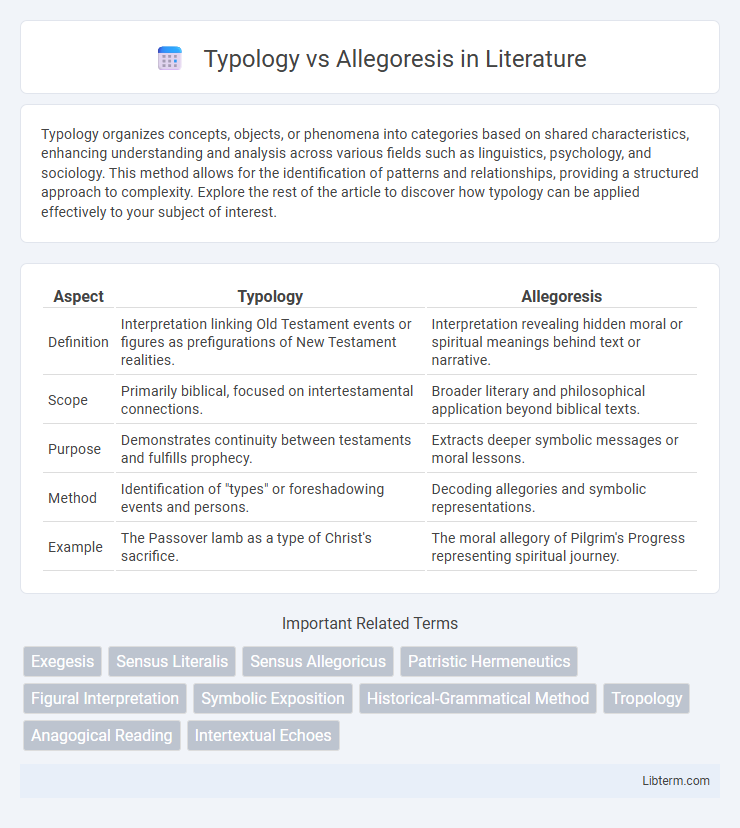Typology organizes concepts, objects, or phenomena into categories based on shared characteristics, enhancing understanding and analysis across various fields such as linguistics, psychology, and sociology. This method allows for the identification of patterns and relationships, providing a structured approach to complexity. Explore the rest of the article to discover how typology can be applied effectively to your subject of interest.
Table of Comparison
| Aspect | Typology | Allegoresis |
|---|---|---|
| Definition | Interpretation linking Old Testament events or figures as prefigurations of New Testament realities. | Interpretation revealing hidden moral or spiritual meanings behind text or narrative. |
| Scope | Primarily biblical, focused on intertestamental connections. | Broader literary and philosophical application beyond biblical texts. |
| Purpose | Demonstrates continuity between testaments and fulfills prophecy. | Extracts deeper symbolic messages or moral lessons. |
| Method | Identification of "types" or foreshadowing events and persons. | Decoding allegories and symbolic representations. |
| Example | The Passover lamb as a type of Christ's sacrifice. | The moral allegory of Pilgrim's Progress representing spiritual journey. |
Introduction to Typology and Allegoresis
Typology is a method of biblical interpretation that identifies patterns and foreshadowing in Scripture, where earlier events or figures (types) prefigure later ones (antitypes), establishing a theological connection across texts. Allegoresis, on the other hand, interprets biblical narratives symbolically or metaphorically to uncover hidden spiritual meanings beyond the literal sense. Both approaches enrich theological understanding, with typology emphasizing historical fulfillment and allegoresis focusing on spiritual significance.
Defining Typology: Meaning and Origins
Typology is a method of biblical interpretation that identifies persons, events, or institutions in the Old Testament as prefigurations or "types" of New Testament fulfillment, reflecting a divinely intended foreshadowing. It originated in early Christian theology, with Church Fathers like St. Augustine developing its framework to reveal the continuity between the Testaments. The meaning of typology centers on uncovering deeper spiritual truths by connecting historical realities to their ultimate theological significance.
Understanding Allegoresis: Concept and Development
Allegoresis is a method of biblical interpretation that reveals hidden spiritual meanings beyond the literal text, rooted in early Christian exegesis and developed through patristic scholarship. It contrasts with typology by focusing on allegorical or symbolic understanding rather than direct historical or prophetic foreshadowing. The evolution of allegoresis highlights its role in bridging scriptural narratives with theological doctrines, enriching the interpretive tradition within Christian theology.
Historical Contexts of Typology and Allegoresis
Typology and allegoresis both emerged within early Christian exegesis to interpret Scripture, with typology emphasizing the identification of Old Testament events as prefigurations of New Testament realities, grounding its method in historical continuity. Allegoresis, by contrast, evolved from Hellenistic philosophical traditions, focusing on uncovering deeper spiritual or symbolic meanings beyond the literal text. The historical context of typology is closely linked to early Church Fathers who sought to validate Christian doctrine through biblical prophecy fulfillment, whereas allegoresis was influenced by Platonic thought, often used to reconcile Scripture with broader metaphysical concepts.
Key Differences Between Typology and Allegoresis
Typology interprets Old Testament events and figures as prefigurations of New Testament realities, emphasizing concrete historical correlations. Allegoresis, by contrast, seeks deeper symbolic meanings beyond the literal text, often applying spiritual or moral interpretations irrespective of historical context. The key difference lies in typology's focus on fulfillment within Christian salvation history, whereas allegoresis prioritizes abstract, moral, or mystical lessons.
Functions and Purposes in Hermeneutics
Typology functions in hermeneutics by identifying prefigurations in scripture where earlier events or figures foreshadow later ones, serving to reveal divine continuity and fulfillment across biblical narratives. Allegoresis interprets texts by extracting deeper, often spiritual or moral meanings beyond the literal sense, aiming to provide ethical guidance and theological insight. Both methods enhance understanding by connecting texts across contexts, with typology emphasizing historical fulfillment and allegoresis focusing on symbolic significance.
Typology and Allegoresis in Biblical Interpretation
Typology in biblical interpretation identifies people, events, or institutions in the Old Testament as foreshadowing or prefiguring New Testament realities, establishing a direct connection between Scripture's two testaments. Allegoresis, by contrast, interprets biblical texts symbolically or spiritually beyond their literal meaning, often revealing deeper theological or moral lessons. Typology relies on historical and covenantal continuity, whereas allegoresis embraces imaginative, layered meanings within biblical narratives.
Examples of Typological and Allegorical Readings
Typological readings identify Old Testament events or figures as foreshadowing New Testament realities, such as Jonah's three days in the fish symbolizing Christ's resurrection after three days. Allegorical readings interpret biblical narratives symbolically to reveal deeper spiritual meanings, like the Song of Songs representing the soul's love for God. Both approaches enrich scriptural understanding by uncovering layers of meaning beyond the literal text.
Contemporary Relevance in Literary and Theological Studies
Typology and allegoresis remain vital interpretative frameworks in contemporary literary and theological studies, enabling deeper engagement with texts through symbolic meaning. Typology emphasizes historical foreshadowing and fulfillment, often linking Old Testament events to New Testament realities, while allegoresis explores broader spiritual or moral interpretations beyond literal sense. The ongoing scholarly interest in these methods reflects their capacity to enrich understanding of narrative structures, doctrine development, and cultural contexts in modern hermeneutics.
Conclusion: Typology vs Allegoresis—Which Approach and When?
Typology emphasizes interpreting biblical events as prefigurations of future realities, grounding meaning in historical continuity and covenant fulfillment. Allegoresis seeks deeper, often spiritual or moral significance beyond literal text, allowing flexible application across contexts. Choosing between typology and allegoresis depends on whether one prioritizes theological coherence with scripture's historical narrative or broader moral and philosophical insights.
Typology Infographic

 libterm.com
libterm.com